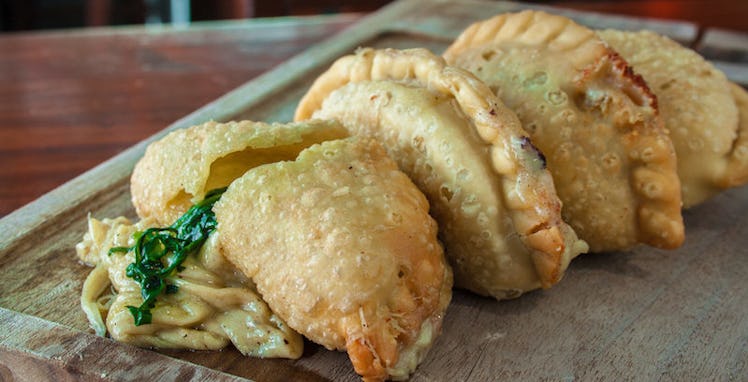
How To Lighten Up Latin Food Without Losing The Flavor Or Culture
Growing up in a Dominican household, I was raised eating fried plantains, fried cheese and lots and lots of beef.
A regular morning in the Dominican Republic consisted of a heavy breakfast known as “Los Tres Golpes.”
Los tres golpes consists of mangu served with fried eggs, salami and fried white cheese. It’s delicioso!
This heavy breakfast is a staple in the country that will keep you going all day.
In the Dominican Republic, however, because most of the people are out in the sun working, the protein-rich food tends to even out.
In Caribbean countries, fresh fruit and vegetables are always available, so the food is naturally healthier.
As a Dominican-American working in an office, I've had to reconsider my diet.
For a long time, I rarely ate Latino cuisine for fear of becoming an unhealthy eater.
But, I had to face it: My mind, body and soul needed the comfort food.
Here are four healthy Latino dishes along with some healthy tips that will leave you feeling closer to home, without putting a dent in your fitness goals.
Baked Plantains With Avocado Crema
This recipe is one of my favorites.
Rather than frying ripe plantains in heavy cooking oil, they are baked.
Baking the plantains is the healthiest form of cooking them, as it leaves the plantains crispy on the outside and soft on the inside.
In this recipe, whole milk is replaced by almond milk and 0 percent fat Greek yogurt.
Cooking oil is replaced with coconut oil, and table salt is replaced with sea salt.
The core ingredients (plantains and avocado) are still there, and trust me when I tell you that not one ounce of flavor is lost on this dish.
Slower Cooker Sofrito
Christmas is almost here.
Leftover turkey does not have to be subjected to turkey sandwiches, and bones do not have to be thrown out, all thanks to this slow cooker sofrito recipe.
This recipe was created by Irina Gonzalez, the founder of the blog Healthy Latin Food.
It's the perfect way to not only use those leftovers, but also bring that Latin flavor to any dish.
This broth can be used on soup, meats and chili.
The best part about this sofrito is you can keep it in your freezer for months.
Very Berry "Mojito" Smoothie
Another great way to eat healthy without losing your culture is by incorporating Latino flavors into your smoothies.
The Very Berry “Mojito” Smoothie does exactly that.
Sorry, there is no alcohol in this recipe, but feel free to add rum if you wish.
Just keep in mind that health benefits largely decrease when adding alcohol.
This smoothie calls for the usual berries, and it's topped off with coconut water and chopped mint leaves to give it that mojito taste.
Latin American Empanadas
Much like the first recipe, these empanadas are baked rather than fried.
Pumpkin seeds, ground cumin and reduced-sodium chicken broth are added for flavor and nutrition.
Ground beef is kept in the dish as the main ingredient, but lean beef is used rather than the traditional ground beef.
This is a perfect pre-workout meal, as it has just the right amount of carbs and protein to keep you going.
Aside from researching new dishes from Latino cooks and bloggers, learning how to make the same dishes our abuelitas made for us into healthy meals is a step well worth taking.
Creating the dishes we grew up with healthier ingredients will help us maintain our culture in our ever-changing lifestyles.
Here are some tips from "Cooking Healthy Latino Style" on how to reduce the calorie intake in our rich meals:
1. When cooking beef and pork, trim all visible fat prior to cooking, and cut back on the amount of meat in the recipe by adding or increasing the amount of beans.
Beans are a great source of protein.
Mushrooms are also a great replacement to beef. When cooked shitake mushrooms have the same earthy, meaty flavor most Latino dishes crave.
2. Use 1 percent, low-fat, fat-free, coconut or soy milk in your dishes.
3. Reduce the amount of cheese in dishes by using a smaller amount of cheese that is stronger in flavor, such as sharp cheddar.
4. For creams and soups, puree some of the vegetables or beans after they have cooked, and add them back into the soup to thicken, instead of adding cream.
5. Use pink Himalayan salt as a substitute for table salt, and use fresh herbs such as cilantro, lemon, parsley or rosemary to brighten flavors.
6. Replace heavy cooking oil with extra virgin olive oil whenever possible.
We don’t have to abandon our culture in order to eat healthy.
Let’s remake abuelita’s dishes and keep them as part of our lifestyle.
We can have our flan and eat it, too!